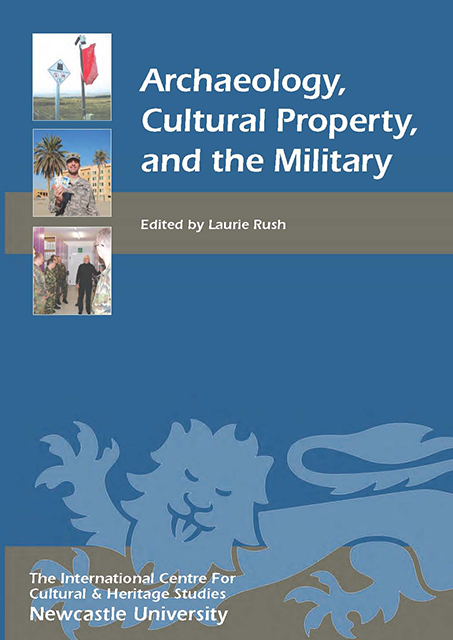Book contents
- Frontmatter
- Contents
- List of Illustrations: Figures and Tables
- Archaeology and the Military: An Introduction
- 1 The Obligations Contained in International Treaties of Armed Forces to Protect Cultural Heritage in Times of Armed Conflict
- 2 Rescuing Europe’s Cultural Heritage: The Role of the Allied Monuments Officers in World War II
- 3 The UK’s Training and Awareness Programme
- 4 US Army Civil Affairs: Protecting Cultural Property, Past and Future
- 5 Cultural Property Protection in the Event of Armed Conflict: Deploying Military Experts or Can White Men Sing the Blues?
- 6 Good Training and Good Practice: Protection of the Cultural Heritage on the UK Defence Training Estate
- 7 In-Theatre Soldier Training through Cultural Heritage Playing Cards: A US Department of Defense Example
- 8 Dealing the Heritage Hand: Establishing a United States Department of Defense Cultural Property Protection Program for Global Operations
- 9 Teaching Cultural Property Protection in the Middle East: The Central Command Historical/Cultural Advisory Group and International Efforts
- 10 Cultural Resources Data for Heritage Protection in Contingency Operations
- 11 Time not on my Side: Cultural Resource Management in Kirkuk, Iraq
- 12 US Military Support of Cultural Heritage Awareness and Preservation in Post-Conflict Iraq
- 13 Operation Heritage
- 14 Cultural Property Protection in the Event of Armed Conflict – Austrian Experiences
- 15 The Role of the Swiss Armed Forces in the Protection of Cultural Property
- 16 Preserving Global Heritage from Space in Times of War
- Appendix 1 1954 Hague Convention and its two Protocols
- Appendix 2 Author Biographies
- Index
13 - Operation Heritage
Published online by Cambridge University Press: 28 February 2023
- Frontmatter
- Contents
- List of Illustrations: Figures and Tables
- Archaeology and the Military: An Introduction
- 1 The Obligations Contained in International Treaties of Armed Forces to Protect Cultural Heritage in Times of Armed Conflict
- 2 Rescuing Europe’s Cultural Heritage: The Role of the Allied Monuments Officers in World War II
- 3 The UK’s Training and Awareness Programme
- 4 US Army Civil Affairs: Protecting Cultural Property, Past and Future
- 5 Cultural Property Protection in the Event of Armed Conflict: Deploying Military Experts or Can White Men Sing the Blues?
- 6 Good Training and Good Practice: Protection of the Cultural Heritage on the UK Defence Training Estate
- 7 In-Theatre Soldier Training through Cultural Heritage Playing Cards: A US Department of Defense Example
- 8 Dealing the Heritage Hand: Establishing a United States Department of Defense Cultural Property Protection Program for Global Operations
- 9 Teaching Cultural Property Protection in the Middle East: The Central Command Historical/Cultural Advisory Group and International Efforts
- 10 Cultural Resources Data for Heritage Protection in Contingency Operations
- 11 Time not on my Side: Cultural Resource Management in Kirkuk, Iraq
- 12 US Military Support of Cultural Heritage Awareness and Preservation in Post-Conflict Iraq
- 13 Operation Heritage
- 14 Cultural Property Protection in the Event of Armed Conflict – Austrian Experiences
- 15 The Role of the Swiss Armed Forces in the Protection of Cultural Property
- 16 Preserving Global Heritage from Space in Times of War
- Appendix 1 1954 Hague Convention and its two Protocols
- Appendix 2 Author Biographies
- Index
Summary
The culture of Iraq has always been of the utmost importance to its people and to the international community. Following the 2003 invasion of Iraq (and notwithstanding the priority requirements of life support, medical facilities and infrastructure repair that the Iraqi people required) it was important that cultural issues – issues that underpinned the historical identity of Iraq – were addressed, and to that end it was deemed appropriate that a cultural initiative be originated and developed with a long-term view to the future.
Before taking command of British troops in Multi-National Division (South East) (MND(SE)) in February 2008, Major General Barney White-Spunner, General Officer Commanding 3rd (United Kingdom) Division, met with Dr Neil MacGregor, Director of the British Museum, to discuss the feasibility of the British Army and the British Museum working jointly to assist the Iraqi Ministry of State for Antiquities and Tourism in developing a cultural heritage project in southern Iraq. From these discussions Operation Heritage was born. From the outset, its aim was to identify key heritage sites and museums in southern Iraq, assess the state that they were in and, in coordination with the Iraqi authorities and the British Museum, implement a plan to safeguard these sites and museums.
In my role as Military Assistant to Major General White-Spunner in Basra I was identified, jointly with Dr John Curtis, Keeper of the Middle Eastern Department of the British Museum, as the project manager for this initiative, and in meetings held at the British Museum and Bulford, home to the Headquarters of the 3rd (United Kingdom) Division, we drew up a plan for the project with the following nine initial objectives:
• to seek approval from the Government of Iraq for the project
• to establish key liaison routes between the British Museum, the British Army and the Iraqi Ministry of State for Antiquities and Tourism
• to secure funding for the different aspects of the project
• to nominate the important cultural heritage sites in southern Iraq and carry out assessments with a team of experts
• to establish training courses for museum curators at the British Museum
• to assess security at key heritage sites
• to assist with and help to coordinate infrastructure repair as required
• to liaise with Government of Iraq Ministries and other Coalition partners to ensure that there is a coordinated approach on heritage issues pan-Iraq
- Type
- Chapter
- Information
- Archaeology, Cultural Property, and the Military , pp. 138 - 144Publisher: Boydell & BrewerPrint publication year: 2010
- 3
- Cited by

